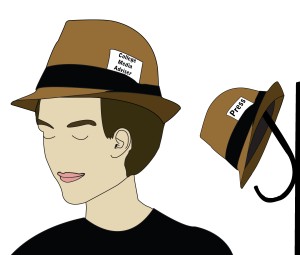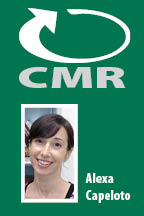From professional reporters and editors to professional advisers: Veteran advisers share their stories
By Alexa Capeloto
John Jay College of Criminal Justice/CUNY

Jake Lowary says he loves advising The All State student newspaper and Monocle yearbook at Austin Peay State University in Clarksville, Tenn. But he recalls “a definite learning curve” moving from professional newspaper reporter to college media adviser nearly two years ago.
The curve can feel steep when reporters and editors become advisers.
On one hand, working with college media can feel like a natural extension of a journalism career. You pass on all the things you learned as a journalist to future generations, and stay connected to news production via a student newspaper, online publication or broadcast station.
 On the other hand, professional journalists may have far less experience developing budgets, helping students craft media bylaws and attending campus meetings as an adviser and/or faculty member rather than as a reporter covering the meetings.
On the other hand, professional journalists may have far less experience developing budgets, helping students craft media bylaws and attending campus meetings as an adviser and/or faculty member rather than as a reporter covering the meetings.
A Different Pace
Linda Villarosa, journalism director at The City College of New York, a city university in Manhattan, says she was used to barreling through tasks and assignments as an editor at The New York Times, executive editor of Essence magazine and in other journalism jobs.
Now, as a professor, student media adviser and program director, Villarosa says she has to pace her work—and her expectations— to suit the world of higher education.
“This is a slow (moving) community of people,” Villarosa says. “You have to dial it down to get what you need. Journalism is very brash and outspoken; you just blurt out things and expect things to happen quickly.”
Lowary agrees, saying he was used to “a very aggressive, fast-paced sort of atmosphere” as a reporter at The Leaf-Chronicle, a mid-sized Gannett paper in Clarksville. At the university level, he says, “It’s not that way.”
“We have this idea that we’re going to do something (and then) we have 10 meetings over the course of three months, and (then) three months after that, it might come to fruition. It’s a very difficult concept for me to grasp,” he says.
Marla Krause spent 22 years as a reporter and editor at the Chicago Tribune. As at most large newspapers, deadlines were unrelenting, decisions were made quickly, and there was a multi-layered organization to handle the various pieces of any project.
Krause is now at DePaul University, a large Catholic university in Chicago, where she is a professor and adviser for The DePaulia student newspaper. She, too, has experienced the length of time a project can take in a college setting. It took about a year to establish more sites for DePaulia news-stands. A DePaulia marketing plan has been in the works for five years, about as long as Krause has been at the school. Even posting promotional posters, she notes, can be a process.
Keeping the “Student” in Student Newspaper
Of the transition from professional newsroom to student newsroom, Krause says, “When you’re an editor at a professional publication, certainly you’re doing a public service and the public has to trust you. But if you do make a mistake, you feel it’s your own reputation; it’s just you who would have to take the knocks.
“Whereas if something really bad happens to a student paper, you don’t want the students to get in trouble. I feel a great responsibility to teach them the right way to do things.”
But, at the same time, advisers need to remember it’s the students’ newpaper—not theirs, Krause adds.
Some advisers struggle to adapt to the hands-off-the-content approach adopted at many colleges. To go from doing journalism to advising and critiquing is harder than it might seem at first, they say.
“Keep One Foot in the Newsroom”
Paul Moses, a journalism professor and adviser at Brooklyn College, another city university in New York, says he fills that void by continuing to write and stay connected to professional journalism. Like a lot of advisers, he still considers himself a journalist and has learned to balance the two identities.
“Keep writing,” advises Moses, who spent 17 years at New York Newsday before joining the college in 2001. “Maintain your relationships in the business. I think that’s important for students. Keep one foot in the newsroom.”
Villarosa subscribes to the “teaching hospital model” that some are beginning to apply to journalism education. Like Moses, she believes journalism teachers should be practicing professionals, and should be as current in their skills and work as any future journalist is required to be.
Adviser Objectivity?
Moses also holds to the tenets of objectivity he practiced as a journalist. Mainstream news pros typically do not sign petitions, attend demonstrations, donate to political candidates or do anything else that might convey a bias, and he sticks to that as a professor and adviser.
“I just try to stay out of things,” he says, citing petitions and union work as examples. “For us it’s just force of habit, (but) the students also need some model of that kind of nonpartisan approach. It’s hard for them to adapt to that.”
Advisers take different views on this issue. Lowary, for one, felt the constraints of public neutrality lift when he became a full-time staff member of a university. He put a political bumper sticker on his car, he feels freer to voice his opinions on social media, and he’s open with his students about his political views.
“It’s kind of a strange theory that I can actually put a political sign in my yard now,” he says. “I always feel like I‘m looking over my shoulder for having this sticker on my car, but it’s kind of liberating.”
Final Tips
Whether or not they embrace political advocacy, college media advisers quickly learn the importance of advocating for student journalists. Many advisers work with their students to arrange meetings with college administrators to explain how their media organizations work and what they seek to achieve.
Other advisers facilitate roundtables with local media professionals; such roundtables connect media companies and promising student journalists.
Another bit of advice to any new adviser is to stay nimble. As the professional media landscape undergoes a sea change, so too does the student media landscape.
Teaching and advising media, she says, are demanding and involve a three-pronged skillset: fundamental journalistic abilities that stem from professional experience, effective teaching and multi-media know-how.
Krause believes a successful adviser is one who stays focused on the needs and abilities of the students, whatever they might be.
“The students you are working with are just that. They’re students,” she says. “It’s different from when you’re working in a newsroom and you’re surrounded by people with years of experience. They’re learning.”
For that reason, Krause has three words of advice that her fellow advisers echo: “Patience, patience, patience.”
Here are some more specific tips for the journalist who is transitioning from a professional career to one in college media advising:
1) Join a Network: Connect with organizations like the College Media Association, Associated Collegiate Press and the Student Press Law Center to learn about the law and best practices of student media advising. You can begin with CMA’s New Adviser Handbook.
2) Write Your Role: Craft a job description for yourself if one does not already exist, and share with supervisors and students.
3) Write the Student Media Role: Work with students on a staff manual, style manual, mission statement and other written codes, if they do not already exist.
4) Hold the Red Ink: At least until after publication. An adviser guides students and critiques their published work. Prior review is generally discouraged for pedagogical and legal reasons.
5) Check Your Compass: Consider whether and how your personal code of ethics as a professional journalist should change as a media adviser.
6) Follow the Money: Even the math-challenged among us must learn about budgeting, ad sales and the other dollar-driven duties of any organization.
7) Connect with the College: Bring student journalists together with college administrators, PR people and other staffers to make clear the value (but also independence) of student media.
8) Connect with Local Media: Hold roundtables and other gatherings for media professionals and student journalists.
9) Keep Writing: Stay as engaged as possible with professional journalism by freelancing, blogging or other writing. Such work keeps you current as a teacher and adviser, but also feeds the journalist that never quite leaves us.
10) Stay Nimble: Be open to changes in your students or their work, such as a digital-first publication or redrawn staff structures, and be patient with the slower pace of higher education.
Alexa Capeloto is an assistant professor at John Jay College of Criminal Justice/CUNY in New York City. She teaches journalism, co-coordinates the Journalism minor and serves as faculty adviser for the student newspaper, The John Jay Sentinel. After earning her master’s degree in journalism from Columbia University in 2000, she spent five years as a reporter and editor at the Detroit Free Press. In 2005 she joined the San Diego Union-Tribune as East County bureau chief. Two years later she was named the paper’s enterprise editor, overseeing investigative, explanatory, trend and other enterprise stories. In 2007, while still at the U-T, she began teaching as an adjunct instructor of journalism at National University, a San Diego-based college aimed at mid-career students. She has been on faculty at John Jay since 2009.
